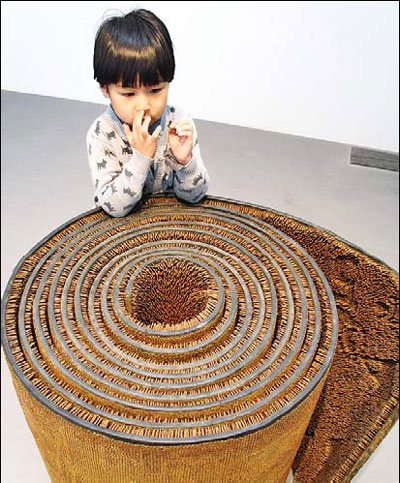
 |
|
A girl is attracted by Sui Jianguo's sculpture Kill on display at Beijing's 798 art zone. Jiang Dong / China Daily |
Veteran sculptor Sui Jianguo is known for his frequent - and often unorthodox, if not bizarre - use of symbols associated with Mao Zedong.
And his sometimes-strange portrayals of New China's founding father upset some people.
One well-known piece depicts Mao in deep sleep like the Buddha on his sickbed. Another is a 12-meter-long portrayal of Mao's right arm, with the palm open and the fingers spread out, as if he were waving to Red Guards during the "cultural revolution" (1966-76).
"I am often, if not always, misunderstood, and my art is misinterpreted."
Last October, one piece from his magnum opus Legacy Mantel series was shown at the recently renovated National Museum of China for the National Painting Academy of China's 30th anniversary celebrations.
He is staging a small-scale but comprehensive retrospective solo show at Pace Beijing in the 798 art zone with the simple title Sui Jianguo.
"It is sort of a collective debut for my sculptures," Sui says.
On view are more than 30 metal or fiberglass sculptures, installations and videos he has created since the mid-1980s.
In addition to the Legacy Mantel series, eye-catching pieces include Earthly Force, Sealed Memory, Drapery Study, Shape of Time and The Great Acceleration, a video-installation showing bullet trains' test-runs.
Critics call Sui a "pioneer who has pushed the farthest in conceptual and philosophical art" on the mainland.
But Sui disavows such ascriptions.
"I just follow intuition when I create," he says.
"My works that appear philosophical reflect my emotions."
Sui is often described as a vanguard artist, who wins critical acclaim and market recognition in the West.
But he insists: "I am forever a child of the Mao era."
Unlike younger artists, Sui says his personal history, habits, mindset and skeptical attitude toward life - "all bear indelible imprints of the period when Mao ruled over modern China".
Born in 1956 to a workers' family - his parents never went to school - Sui studied traditional Chinese painting and classical literature for a few years.
He went to work in a factory at 16 and began self-study at 18, during the "cultural revolution". He enrolled in college at 24, when the reform and opening-up began.
In the 1980s, he finished a master's degree at the Central Academy of Fine Arts, where he has since continued teaching.
"I was living a perfect life in others' eyes," recalls Sui, who is also the former dean of the sculpture department of the academy, which is the country's top art education institution.
"But I constantly felt anxieties and internal conflicts I couldn't live as an indifferent onlooker during drastic social changes."
He has since addressed social issues from a sculptor's perspective.
"For me, sculptural art is an instrument for self-exploration, self-expression and self-healing," he says.
Sui has brought fundamental changes to China's contemporary art scene, with his influential works and educational efforts.
"Abstract and conceptual art has been gradually become accepted by ordinary folks and by the authorities," Sui says.
His early works dealt with the tension between different materials and mediums.
In Earthly Force, Sui entwines huge boulders in nets made from steel ropes to present a strong sense of confrontation. In Sealed Memory, Sui makes a closely welded cabinet of thick steel sheets, creating a feeling of anxiety and imprisonment.
Since the late 1990s, Sui has created art with strong political connotations, such as his signature work, Legacy Mantle series.
Legacy Mantle depicts a kind of plain suit Chinese people call zhongshanzhuang - erroneously called "Mao suits" by Westerners - originally designed as a democratic statement by the early 20th-century revolutionary and Republic of China founder Dr Sun Yat-sen.
The suits became extremely popular from the 1950s-70s, because Mao and his ministers wore them.
"(The suit) could represent revolution, democracy or the lack thereof, a utopian social ideal or the Chinese people's collective unconsciousness," Sui explains. "Its meanings are aplenty and change with the times."
But a more representative symbol, Sui says, is seen in his 2006 work Great Acceleration.
The video installation features 12 pieces of footage Sui shot with hidden cameras at a bullet train test ground. Sui believes it represents China now.
"China runs at a breakneck speed to catch up with Western powers," he says.
"Doing so has taken its toll - growing environmental and health problems, for instance."